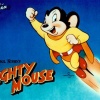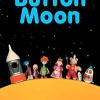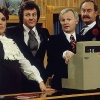I will admit it. I had an imaginary friend when I was a pre-schooler. It wasn't a boy or girl my own age, however; it was a mouse.
Not just any mouse though: my pretend pal was none other than Mighty Mouse, a superhero rodent able to fly, use x-ray vision and was so strong he could hold off enemies without getting hurt himself. Oh, he could occasionally control inanimate objects and turn back time too. Not bad for somebody under 10 inches high. (The cartoon mouse is not to be confused with the U.S. Ultimate Fighting Champion Demetrious Johnson, whose nickname is also Mighty Mouse.)
Mighty Mouse is pretty old now, but he’s still in the superhero game. His first appearance on screen was in The Mouse of Tomorrow, a short that went out in U.S. cinemas in 1942. He was drawn wearing a blue outfit with red shorts and a cape, in a parody of the slightly larger crusader for justice, Superman. To complete his imitation of the Man of Steel, the smaller hero was also called Super Mouse for his first few films.
Later, the furry protagonist developed a more distinct personality of his own: in 1944, for the film The Wreck of the Hesperus, his name was upgraded to Mighty Mouse. This may also have had something to do with the fact that his creator, Paul Terry, discovered that a comic, also entitled Super Mouse, was about to be published by another company. Additional fact: prolific U.S. screenwriter, cartoonist, director and producer Terry was the founder of the Terrytoons animated cartoon studio which was also responsible for Heckle and Jeckle and Deputy Dawg, amongst others. Second additional fact: the whole idea for a Mighty Mouse type cartoon actually came from Isadore Klein but she originally suggested ‘Super Fly’. Terry didn’t like it and changed the character to a mouse instead.
A redrawing and a costume change came next: Mighty Mouse’s outfit was swapped for a yellow body suit with red trunks and cape (although in some films he appeared in reversed colours) and from 1945 much of the cartoon’s dialogue was done in the style of an opera. This may sound slightly peculiar but the actor/opera singer Mario Lanza was becoming popular at the time and presumably the cartoon studio was attempting to cash in on this. As he swooped into the thick of the danger, Mighty Mouse would sing ‘Here I come to save the daaaaaaay!’ Ace Ventura (the pet detective played by Jim Carrey) referenced this in his first film as he set off to solve his mystery – something I only realised could be attributed to Mighty Mouse very recently.
MM – as I shall now be calling him to save time – was voiced by several actors over the years. The first was Roy Halee, Senior, followed by Tom Morrison and then Allen Swift, a children’s television presenter and voice actor. In a later reincarnation Alan Oppenheimer took on the role and, in his last series, MM was given a voice by Patrick Pinney. Singing aside, he was actually a mouse of few words and, unlike many other superheroes, such as Spiderman, didn’t give his time to making smart remarks while fighting crime.
No superhero would be complete without a love interest and MM’s bravery attracted many over the years, with names like Sweet Susette and Gypsy Princess. The most consistent of his girlfriends, however, was Pearl Pureheart – a sassy mouse with movie star glamour who regularly helped MM ward off the evil plans of his archenemy: Oil Can Harry.
Harry was a dandily dressed cat with a Dali-esque moustache who also had eyes for Pearl (try not to think about the reality of that situation); although that was not how he was first seen on screen.
Originally he was part of another set of Terrytoon cartoons in the 1930s, as a man rather than an animal. Forgotten about for just under a decade, he was then given a radical makeover to transform him into a recurring pain in MM’s side. The conversations between the three of them were often sung, with Oil Can Harry singing bass-baritone, MM tenor and the beautiful Pearl singing soprano. (It sounds awful, when written down like that but it did actually work, somehow…)
Infuriating though Harry’s constant interferences were, thankfully the forceful little vermin would always fight ferociously to rescue his sweetheart, defeat the feline and spoil his dastardly plans and swoop off to victory, as he would against any other enemies that popped up all over the place.
When he wasn’t faced with Harry’s trickery, MM was always on hand to help out. Being little didn’t seem to hamper him any; he would streak across the sky in the manner of a comet with a bright red vapour trail to help rescue the Earth’s inhabitants from natural disasters such as volcanoes and floods. In the early cartoons he was a pretty hard-core combatant: he would fly right up underneath the chin of his adversary and pummel them until they couldn’t carry on. Many of the beatings he administered were pretty brutal, occasionally ending with a punch so powerful that the bad guys would hurtle through the air until they were out of sight.
MM’s other opponents were mostly ordinary cats, although some were ramped up a little: the Bat-cats were aliens with wheels instead of paws (well, why not?) while, in cartoons aired during the Second World War, when MM was still Super Mouse, cats loosely based on the Nazis were present. On odd occasions a non-cat enemy would appear as well, such as the Automatic Mouse Trap, a robotic dinosaur brute or Bad Bill Bunion, a human.
In 1955 Terrytoons’ cartoon library was bought by U.S. network CBS, who aired Mighty Mouse Playhouse (short animations featuring the eponymous hero) from the December of that year until 1966. This made MM the first cartoon character to appear on U.S. Saturday morning television and this boosted his popularity far more than his cinematic appearances had done.
MM continued to be shown on U.S. TV at different times and, from the late 1970s into the early 1980s, a company called Filmation produced new cartoons using both Mighty Mouse and Heckle and Jeckle. They didn’t go on a particularly huge mental journey to find the title of this one…it was called ‘Mighty Mouse and Heckle & Jeckle’…
A slightly different version of the brave little rodent came in 1987 when animation producer Ralph Bakshi (who had worked at Terrytoons in the 1950s and had a role in the last MM cartoons produced by them) came up with a new series for CBS. Mighty Mouse: The New Adventures had more content aimed at adults and the main character was unveiled with a real-life identity when he wasn’t superhero-ing around: Mike Mouse.
MM appeared in his own comic from 1946 until the 1960s and again for a short time in 1990/1, via Marvel. He has also just been given a new literary outlet, via a new series from Dynamite Comics, which began in June 2017.
There have been rumours floating around, from as early as 2004, that a full length film is going to be made, featuring the strongest mouse in the world but as I write this, I am still waiting for my former imaginary companion to hit the silver screen.
















Do You Remember Mighty Mouse?
Do You Remember Mighty Mouse?